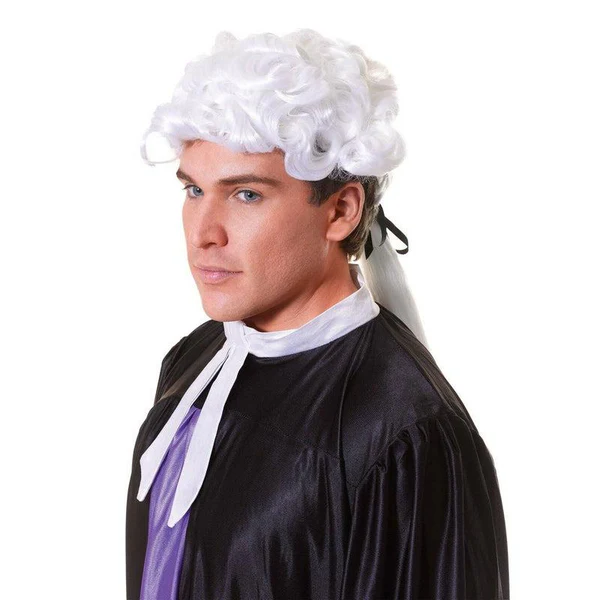
Judge Wig
The Judicial Wig: Upholding Tradition in the Modern Courtroom
The courtroom is a realm steeped in tradition, where the symbols of authority and the trappings of justice hold immense significance. At the heart of this hallowed space stands the judge’s wig, a sartorial relic that has endured the test of time and continues to shape the public’s perception of the legal system. In this blog post, we will explore the fascinating history, the enduring purpose, and the evolving role of the judge wig in the modern legal landscape.
The Origins of the Judicial Wig
The origins of the judge’s wig can be traced back to the 17th century, when the powdered wigs worn by the aristocracy in Europe became a symbol of status and authority. As the legal profession began to adopt these distinctive headpieces, the judge’s wig evolved into a visual representation of the power, impartiality, and gravitas associated with the judiciary.
The adoption of the wig was not merely a fashion statement; it served a practical purpose as well. In an era before modern hairstyling products and techniques, the wig offered a practical solution to the challenges of maintaining a well-groomed appearance in the courtroom, particularly during lengthy proceedings.
As the legal system developed and the role of the judge solidified, the wig became an integral part of the judicial regalia, a tangible manifestation of the solemn responsibilities and the revered position of those who presided over the administration of justice.
The Symbolic Significance of the Judicial Wig
The judge’s wig is more than just a sartorial accessory; it is a powerful symbol that transcends its physical form. The wig’s distinctive appearance, characterized by its curled and powdered strands, has become synonymous with the notion of judicial authority, impartiality, and the rule of law.
By donning the wig, the judge assumes a mantle of gravitas, commanding respect and conveying a sense of formality and solemnity. The wig serves as a visual cue, signaling to all present in the courtroom that the proceedings are being conducted under the auspices of the law, with the judge acting as the impartial arbiter tasked with upholding the principles of justice.
Moreover, the wig’s historical associations with the aristocracy and the upper echelons of society further imbue the judge with a sense of elevated status and authority, reinforcing the notion that the legal system is a sacred institution that operates separate from the whims of the common populace.
The Practical Considerations of the Judicial Wig
While the symbolic significance of the judge’s wig is undeniable, it is essential to recognize the practical considerations that have contributed to its enduring presence in the courtroom.
The wig’s design, with its distinctive curled and powdered strands, serves to conceal the judge’s actual hair, ensuring a uniform and timeless appearance that transcends individual styles or personal preferences. This standardization of the judge’s appearance helps to maintain a sense of impartiality and objectivity, as the focus remains on the individual’s role and authority rather than their physical attributes.
Additionally, the wig’s construction, typically made from horsehair or synthetic fibers, offers a level of durability and resilience that is well-suited to the demands of the courtroom environment. The wig’s ability to withstand the rigors of long proceedings, maintain its shape, and project an air of authority have contributed to its continued use in legal settings.
The Evolving Role of the Judicial Wig
Despite the enduring presence of the judge’s wig, the legal profession has not been immune to the transformative forces of societal change and modernization. In recent years, the role and the relevance of the judicial wig have come under increasing scrutiny, with some questioning its continued utility in the contemporary legal landscape.
Proponents of the wig argue that it remains an essential component of the judicial regalia, upholding the traditions and the solemnity of the legal system. They contend that the wig’s symbolic power continues to command respect and convey the gravity of the proceedings, fostering public trust and confidence in the impartiality of the justice system.
Conversely, critics of the judicial wig assert that it is an outdated relic of a bygone era, one that is increasingly at odds with the modern values of accessibility, transparency, and inclusivity. They argue that the wig’s archaic associations with elitism and exclusivity undermine efforts to make the legal system more representative and responsive to the diverse needs of the community.

The Future of the Judicial Wig
As the debate surrounding the judicial wig continues to unfold, the future of this sartorial symbol within the legal system remains a subject of ongoing discussion and contemplation.
Some legal jurisdictions have already taken steps to modernize the judicial attire, either by modifying the wig’s design or by entirely abandoning its use. These changes reflect a broader effort to align the legal system with the values and expectations of contemporary society, fostering a more approachable and relatable image of the judiciary.
However, the deep-rooted traditions and the symbolic significance of the judge’s wig suggest that its complete disappearance from the courtroom may be a gradual and complex process. Efforts to strike a balance between preserving the gravitas of the legal system and adapting to the changing societal norms will likely shape the future trajectory of the judicial wig.
Ultimately, the fate of the judge’s wig will depend on the ability of the legal profession to navigate the delicate balance between honoring tradition and embracing the evolving needs and expectations of the communities they serve. As the legal system continues to evolve. The role of the judicial wig will undoubtedly remain a topic of ongoing debate and exploration.

Conclusion
The judge wig holds a significant and symbolic role within the legal profession. Its distinctive and historic design reflects tradition and authority. Serving as a symbol of respect and impartiality within courtrooms.
The judge wig’s enduring presence in various legal systems around the world underscores its significance and the importance placed on judicial decorum and tradition. While its usage has faced some debate and challenges in modern times. The judge wig remains a powerful visual representation of the judiciary’s authority and independence.
As legal attire and traditions continue to adapt to contemporary standards. The judge wig’s symbolic importance in upholding the integrity of the judiciary endures. Its historical relevance and cultural symbolism make it a notable feature of legal ceremonies. Evoking a sense of reverence and continuity within the legal profession. The judge wig will likely continue to command respect and reverence as an enduring icon of legal authority and tradition.



